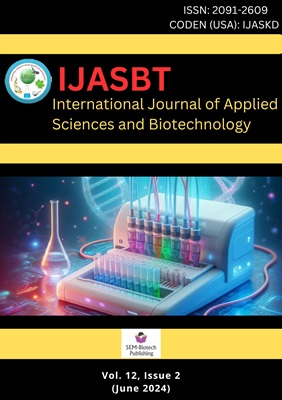Concentrations, Dietary Intake, and Risk Assessment of Heavy Metals (Pb, Cr, and Ni) from Some Brands of Biscuits Sold in Kathmandu, Nepal
DOI:
https://doi.org/10.3126/ijasbt.v12i2.66062Keywords:
Biscuits, dietary intake, heavy metals, Kathmandu, risk assessmentAbstract
Biscuits are flour-based bakery food with high global recognition and acceptance. However, heavy metal contamination in these foodstuffs is of great concern these days since they are a potential threat to consumer health. In this study, the concentration of Pb, Cr, and Ni was determined using a Flame Atomic Absorption Spectrophotometer (FAAS) in a total of 10 popular biscuit brands belonging to four major classes viz., hard sweet, crackers, short dough, and cookies, sold in local grocery shops of Kathmandu, Nepal. Besides, potential health risks of selected metals through consumption of the foodstuffs were also assessed for children and adults as two receptor groups using USEPA deterministic approaches. Results revealed that the concentrations of Pb and Cr in tested samples were in a range of 0.47- 1.00 mg/kg (mean 0.77 mg/kg) and 1.02 - 1.25 mg/kg (mean 1.17 mg/kg) respectively. Nickel was, however below the detection limit. The statistical analysis using one-way ANOVA revealed a significant difference (P < 0.05) in the mean concentration of heavy metals in different samples. The estimated average daily dose (ADDing) of selected heavy metals through the ingestion pathway was below the Provisional Tolerable Daily Intake (PTDI) limits. The hazard index (HI) was within the safe limit (<1) indicating no non-carcinogenic risk to both the receptor groups. Similarly, the metals posed no carcinogenic risks to the groups since the cancer risk (CR) index was within the safe limit (10-6 - 10-4). However, regular monitoring of the production chain and toxic contaminants in the foodstuffs is highly recommended
Int. J. Appl. Sci. Biotechnol. Vol 12(2): 100-114.
Downloads
Downloads
Published
Versions
- 2024-07-15 (2)
- 2024-06-28 (1)
How to Cite
Issue
Section
License
Copyright (c) 2024 International Journal of Applied Sciences and Biotechnology

This work is licensed under a Creative Commons Attribution-NonCommercial 4.0 International License.




